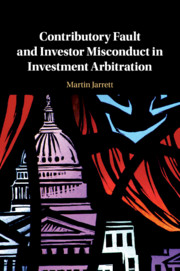Book contents
- Contributory Fault and Investor Misconduct in Investment Arbitration
- Contributory Fault and Investor Misconduct in Investment Arbitration
- Copyright page
- Contents
- Foreword
- Acknowledgements
- Table of Arbitral Awards and Case Reports
- Table of Statutes, Treaties, and Other Documents
- 1 A Schematic of International Investment Law
- 2 A Definition of Defence
- 3 A Theory of Causation for International Investment Law
- 4 Mismanagement
- 5 Investment Reprisal and Post-Establishment Illegality
- 6 A Restatement of Contributory Fault and Investor Misconduct in International Investment Law
- Bibliography
- Index
3 - A Theory of Causation for International Investment Law
Published online by Cambridge University Press: 22 June 2019
- Contributory Fault and Investor Misconduct in Investment Arbitration
- Contributory Fault and Investor Misconduct in Investment Arbitration
- Copyright page
- Contents
- Foreword
- Acknowledgements
- Table of Arbitral Awards and Case Reports
- Table of Statutes, Treaties, and Other Documents
- 1 A Schematic of International Investment Law
- 2 A Definition of Defence
- 3 A Theory of Causation for International Investment Law
- 4 Mismanagement
- 5 Investment Reprisal and Post-Establishment Illegality
- 6 A Restatement of Contributory Fault and Investor Misconduct in International Investment Law
- Bibliography
- Index
Summary
Giving legal content to the defences deriving from contributory fault and investor misconduct begins in chapter 3. As contributory fault is an allegation that the investor also caused the relevant loss, an exposition on causation is undertaken, starting with the ‘factual-legal cause’ approach. After summarising its dictates, it is argued that it is both inadequate, because it does not test for ‘fault causation’ and cannot handle cases of causal overdetermination, and inapplicable in investment arbitrations, given that it was developed for domestic tort law. That critique lays the platform for this chapter’s principal endeavour: creating a new theory of causation. That process consists in constructing a framework, the main planks of which are: one, that causes in law are limited to human conduct, including omissions; two, that there are seven types of consequences in law; and three, that causation in the law is continuous as one consequence can become a cause, in a ‘causal constellation’, for another consequence. The final plank is ‘causal responsibility’: who is legally responsible for a cause? Aside from ridding the causal inquiry of the arbitrariness that prevades it, this theory provides the foundation for dividing contributory fault into two defences: mismanagement and investment reprisal.
- Type
- Chapter
- Information
- Publisher: Cambridge University PressPrint publication year: 2019

